Thai Poetry: Work of Art on Paper
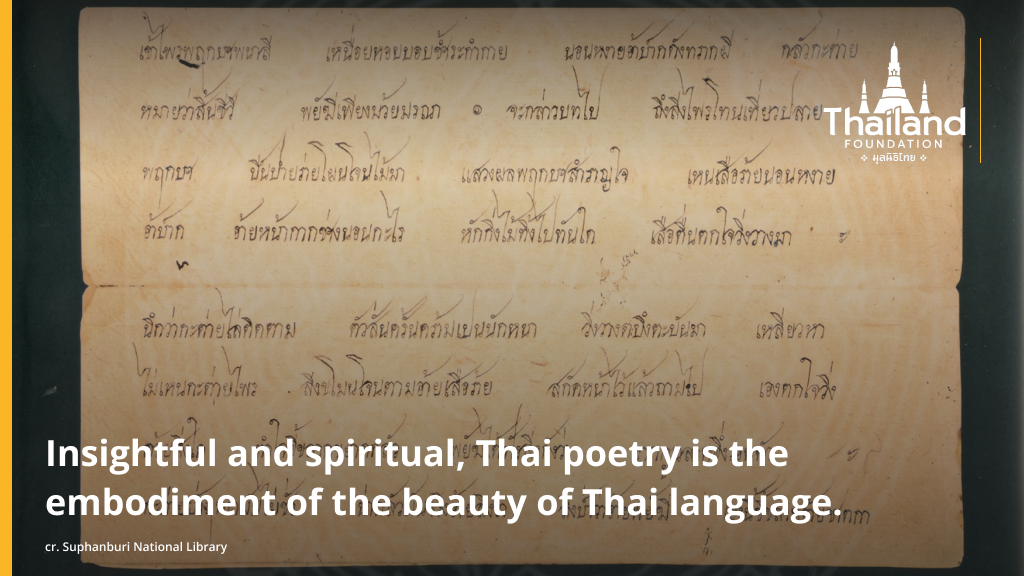
Thais are creative and artistic in our nature. We seek joy and pleasure in aesthetic elements of everyday life whether the food we prepare and embellish with the Thai culinary art, the traditional songs and dances we perform, the sports like muay Thai with fatally beautiful moves and postures, the Thai silk with stunning patterns, and the way we speak our mother tongue. The rich Thai language is an excellent tool for carving the art of communication in a sweet and pleasant form of rhymes. Unlike many other languages in which rhymes are reserved for serious written pieces, the Thai language with 22 vowel sounds, five tones, four tone marks, and 44 consonants, allows Thai speakers to use rhymes in colloquial speech as comfortably as in written language, fostering the rich poetic culture of Thailand that transcends rhyming patterns.
Thai poetry, referred to in Thai as “roy krong” (ร้อยกรอง) or verse as opposed to prose or “roy kaew” (ร้อยแก้ว), is an extensive collection of complex meters called “Chanthalak” (ฉันทลักษณ์) which can be customized and embellished with myriads of techniques and devices to sound as melodious or intense as the imagination and ability of the author allows. Poetry is, therefore, a work of art on paper that offers amusement, spiritual uplifting, and a perfect reflection of the beauty of the Thai language.
- The Poetic Culture
To get a glimpse of what the Thai poetry sounds like, read the following excerpt and notice the rhyming pattern in bold:
Respect to teachers has been paid, a start be made on this old saga,
Of when His Majesty King Phanwasa at Ayutthaya did power wield.
Paramount throughout the world, his writ unfurled far afield,
A source of joy, like heaven revealed, a shield and shelter of the commonality.
Dependencies diverse within his power did cower in awe of such authority.
All lands around the sacred city in humility clasped hands, hands bowed.
The sovereign holder of the royal wealth, perfect in health, with happiness endowed.
The Royal Virtues duly avowed. The common crowd as one was joyful.
This roy krong, composed in the form of Klon Paed (กลอนแปด), is part of a Thai classic called the Tale of Khun Chang Khun Phaen (ขุนช้างขุนแผน). Historian Chris Baker and Professor Pasuk Phonpaichit translated this epic of love, tragedy and war into English while preserving the rhyming characteristic of the Thai poetry. Winner of the Becker Prize, this translation is hailed as one of the best translated literature of the Southeast Asia. Despite of such success, nothing can compare to savoring its literary flavor in the original language.
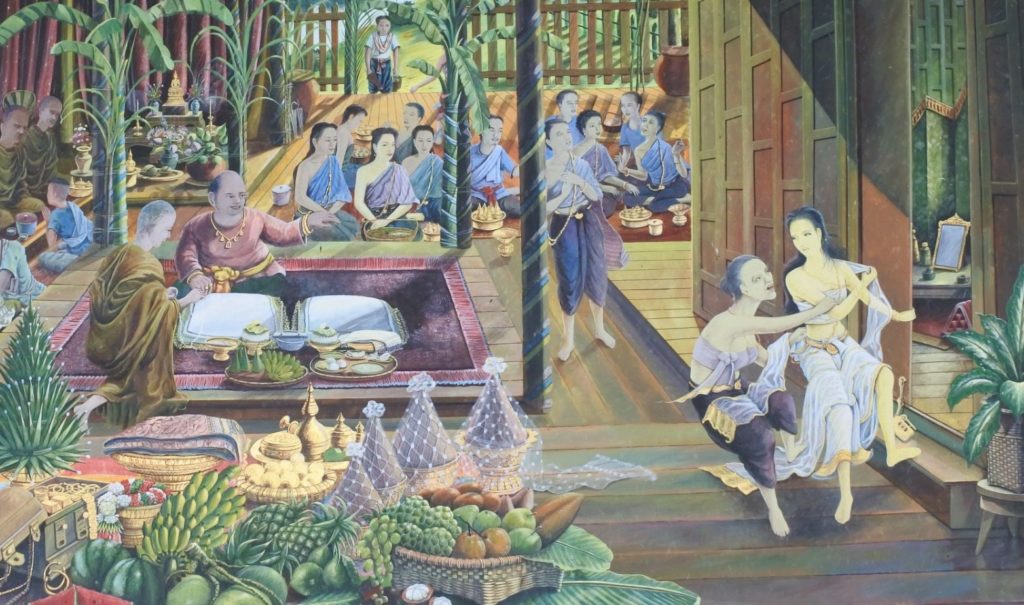
Tale of Khun Chang Khun Phaen (ขุนช้างขุนแผน)
(Photo credit: silpa-mag)
The versatility of Thai poetry
As we have learned that the Thai poetry is an effective language tool for all occasions, for each of the following usages of the poetry, you will find different examples of roy krongs and their summarized translation to show how Thai rhyming meters have served the Thai society from past to present.
- Recording history
Below is an excerpt from the honoring poem to King Taksin the Great of Thonburi (โคลงยอพระเกียรติพระเจ้ากรุงธนบุรี), recording the administrative system under his reign (1767-1782). This roy krong structure is called Khlong Si Suphap (โคลงสี่สุภาพ), involving the use of specific tones and tone marks, which is only possible in a tonal language like Thai. You may notice the bold and underlined syllables for the rhyming pattern. There are totally 85 stanzas in the poem.
- ฝ่ายหมู่มุขมาตย์เฝ้า บริบาล
ชาญกิจชาญรงคชาญ เลิศล้วน
สมุหกลาโหมหาญ หาญยิ่ง
นายกยกพจน์ถ้วน ถี่ถ้อยขบวนความ ฯ
- จัตุสดมภ์เดชล้วน รบือนาม
หกเหล่าอาสาสนาม แกว่นแกล้ว
แปดตำรวจรวดเร็วตาม กมลราช
มหาดเล็กชาววังแพร้ว พรั่งพร้อมรวังวัง ฯ
These two stanzas described the administration then as being composed of a grand chancellor in charge of the central administrative execution, the ministry of interior and the ministry of defense, as well as four commanders called Krom Muang (law and order), Krom Wang (judiciary), Krom Phra Khlang (treasury) and Krom Na (land management).
Regarding the ties with foreign lands, the poem below revealed that in the Thonburi era, Siam had diplomatic relations with Java, Malaysia, China, France, Holland, Portugal, Laos, and the Mons.
แขกชวาวรเทศทั้ง มลายู
จีนฝรั่งลันดาดู ดาษเฝ้า
ลาวมอญย่อมถนอมชู วรบาท พระนา
พระกรุณเหนือเกล้า กล่อมเกลี้ยงควรฐาน ฯ
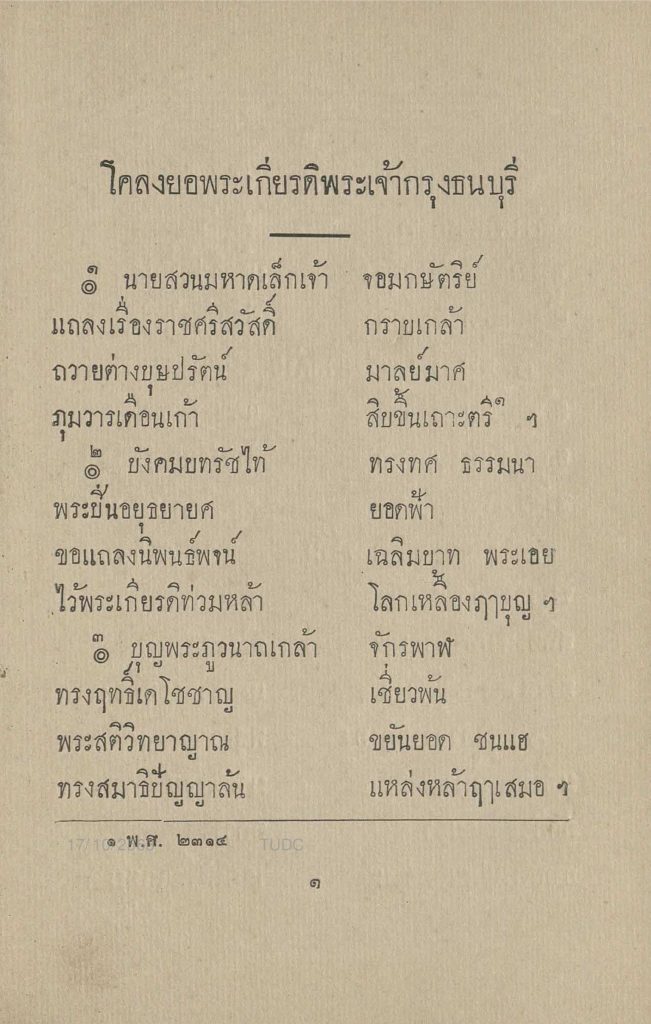
Honoring Poem to King Taksin the Great of Thonburi (โคลงยอพระเกียรติพระเจ้ากรุงธนบุรี)
(Photo credit: wikisource)
- Telling stories and conveying messages
Let’s take a look at Nirat Suphan (นิราศสุพรรณ) by Sunthorn Phu (1786-1855), written around 1831 during his monkhood at the Wat Saket temple. Nirat encompasses any kinds of roy krong with the main purpose to describe a journey. Nirat (นิราศ) is a Thai word that means to depart. In this nirat, Sunthorn Phu recounted his cruelly exhausting and perilous quest for a rare mineral but to no avail, thus this 461-stanza nirat to warn his children and grandchildren not to waste time and effort.
หวังไว้ให้ลูกเต้า เหล่าหลาน
รู้เรื่องเปลืองป่วยการ เกิดร้อน
อายุวัฒนะขนาน นี้พ่อ ขอเอย
แร่ปรอทยอดยากข้อน คิดไว้ให้จำฯ
- Expressing emotions
The Thai people love to write poems on special occasions, for example, to bless their loved ones on Songkran, to congratulate on success, or to console a heartbreak. Poetry is also a profound and captivating expression because not only the author has to deliver a heartfelt or wise message but also to present it within a strict metric structure. Writing touching poetry is no doubt a delicate process requiring great effort. Let’s read Kap Hae Chom Khrueng Khao Wan (กาพย์เห่ชมเครื่องคาวหวาน), a composition by King Rama II (1809-1824) which express the appreciation and fondness of the author to the delectable Thai dishes and his beloved lady who prepared them.
มัสมั่นแกงแก้วตา หอมยี่หร่ารสร้อนแรง
ชายใดได้กลืนแกง แรงอยากให้ใฝ่ฝันหา
(The massaman curry gives off an intense aroma and hot sensation of cumin. Who would not desire you after savoring this curry?)
ก้อยกุ้งปรุงประทิ่น วางถึงลิ้นดิ้นแดโดย
รสทิพย์หยิบมาโปรย ฤๅจะเปรียบเทียบทันขวัญ
(Fresh tiny shrimps in flavorful aromatic spices could kill me with ecstasy. The taste of your dish is unmatched, not even by the taste of paradise.)
In case you want to know more about the Thai food scene and women in the Thai food industry, click here.
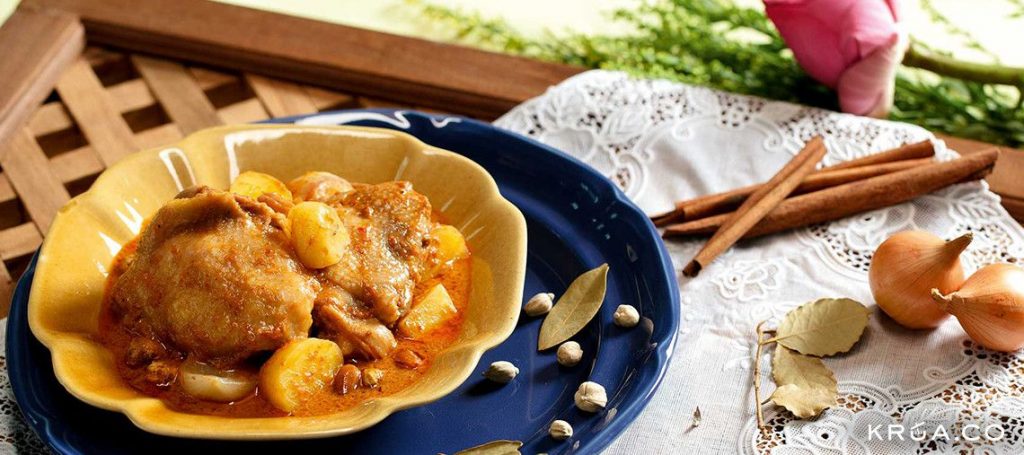
Massaman Curry
(Photo credit: krua.co)
- Serving in state and formal functions
In the Thai tradition, we offer kind and celebratory words in poetry to our loved ones, elders, and important figures. Here is a poem composed by the Royal Society of Thailand to honor Her Majesty Queen Suthida (1978-present) on her 41st birthday.
ศุภมงคลเฉลิมพระชนมพรรษา บรมราชินีศรีกษัตราจักรีสมัย
ถวายพระพรทั่วหล้าประชาไทย ศิระน้อมสวัสดิ์ชัยทรงพระเจริญ
(It is an auspicious occasion to celebrate the birthday of the Queen of the Chakri dynasty. Thai people everywhere offer their blessings. May all luck and glory be on your path. Long live the Queen.)
- Serving in religious setting
Poetry is used in all Buddhist chants and prayers in Thai, especially the melodious chants we call Sorapanya (สรภัญญะ). Take this Kap Chabang 16 (กาพย์ฉบัง 16) which praises the Dharma of the Lord Buddha as an example.
- ธรรมะคือคุณากร ส่วนชอบสาธร
ดุจดวงประทีปชัชวาล
- แห่งองค์พระศาสดาจารย์ ส่องสัตว์สันดาน
สว่างกระจ่างใจมล
- ธรรมใดนับโดยมรรคผล เป็นแปดพึงยล
และเก้ากับทั้งนฤพาน
- สมญาโลกอุดรพิสดาร อันลึกโอฬาร
พิสุทธิ์พิเศษสุกใส
(Dharma is virtue like a bright lamp of the Master that enlightens the minds of all beings. There are eight paths to the cessation of suffering. Together with nirvana, the nine paths will take us to the illuminated, pure and transcendent world.)
- Serving in the world of music
The Thai rhyming patterns from classical poetry are still alive and flourishing in the world of contemporary music and drama. Thai lyrics of pop and rap music are almost impossible without rhyming. Read some verses of the song “Phlaeng Rak” (เพลงรัก) or “Love Song” performed by Anchalee Jongkadeekij, a famous Thai singer who practices Christianity. The Thai poetry is used to describe the experience of the singer as she has been touched by the love of God.
1. เหมือนฝนตกตอนหน้าแล้ง เหมือนเห็นสายรุ้งขึ้นกลางแจ้ง
เหมือนลมหนาวเดือนเมษา เหมือนว่าใจอ่อนล้ากลับแข็งแกร่ง
2. เหมือนคนกำลังมีรัก เหมือนคนหลงทางพบคนรู้จัก
เหมือนเจอของสำคัญที่หล่นหาย เหมือนร้ายนั้นกลายเป็นดีมาก
3. เหมือนที่ฉันนั้นได้มาพบกับเธอ ชีวิตฉันจึงได้เจอ…
(Like a rain in the dry season. Like seeing a rainbow out there. Like a cold breeze in April. Like the weak heart of mine feeling strong again. Like being in love. Like a lost person seeing a familiar face. Like finally finding the long lost dear item. Like the bad turning out to be very good. Like meeting you. And in life, I have found…)
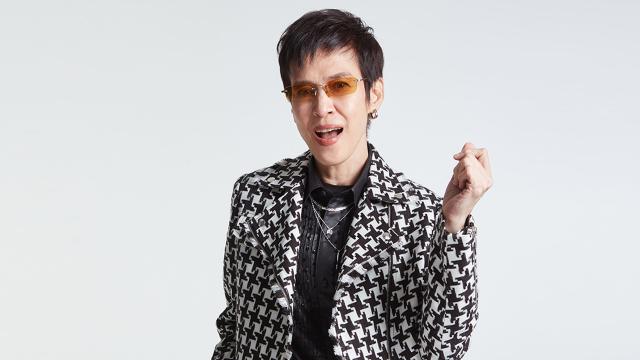
Anchalee Jongkadeekij
(Photo credit: Thairath)
- Serving in literature
From what we have seen, it is not surprising that the Thai literature from the past to the present is inseparable from poetry. We use poetry in the translated classics, such as Ramayana and the Jatakas, in Thai classics, and even textbooks for Thai elementary schoolchildren to learn how to read from fun and easy rhyming lines. Most Thai proverbs and idioms have rhymes to give them a rhythmic stress, such as “Khod Nai Khor, Ngor Nai Kradook” (dishonest people are crooked in their joints and bones), “Raam Mai Di, Tot Pi Tot Klong” (A poor workman blames his tools.)
- The Art of Rhymes and Compositions
- Rules of compositions
There are many forms of Thai poetry, namely Khlong (โคลง), Rai (ร่าย), Lilit (ลิลิต), Klon (กลอน), Kap (กาพย์), Chan (ฉันท์), Kon (กล), all of which must be penned with respect to the rules, known as “Chanthalak” (ฉันทลักษณ์). A good poem must be excellent in three dimensions: message, rhyming techniques, and respect to the Chanthalak.
- The eight elements of Chanthalak in the Thai poetry
- Kha-ru (ครุ) and La-hu (ลหุ)
Kha-ru, meaning “a hard sound,” refers to any syllable with either a long vowel sound, or a short vowel sound with an ending consonant, such as taa (ตา), daam (ดำ), hut (หัด), rian (เรียน).
La-hu, meaning “a soft sound,” refers to any syllable with a short vowel sound and without an ending consonant, such as phra (พระ), cha (จะ), mi (มิ), du (ดุ).
- Ek (เอก) and Tho (โท)
Ek and Tho are two out of four tone marks (Ek, Tho, Tri, Chatawa) in the Thai language.
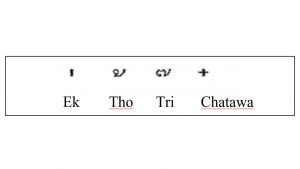
Ek is a syllable or a word with the tone mark Ek, such as pho (พ่อ), mae (แม่), pi (พี่).
Tho is a syllable or a word with the tone mark Tho, such as naa (น้า), paa (ป้า), chaang (ช้าง).
- Khana (คณะ)
Khana is the number of paragraphs and syllables in each type of roy krongs, including the positions of the Ek and Tho syllables and the Kha-ru and La-hu syllables.
- Syllable (พยางค์)
Syllable is a unit of pronunciation with only one vowel sound. It can have either a meaning or no meaning at all. A syllable is the smallest unit of roy krongs.
- Rhyming (สัมผัส)
Rhyming is the use of words that have the same vowel sound and any of ending consonants from the same group, but the ending consonant in each different verse must not be the same one. There are two types of rhyming in the Thai poetry:
– External rhyme (Samphat Nork) means words from different verses that rhyme together. The position of the rhyming words differs depending on the type of poem. The external rhyme is compulsory for the Thai poetry.
– Internal rhyme (Samphat Nai) refers to words in the same verse that rhyme together. It can be a vowel rhyme or a consonant rhyme. The writer is free to use the internal rhyme as much or as little as desired, and there is no specific position for rhyming words. Although this rhyming is optional, it is a great technique to boast the talents of the writer.
- Long-sounding and short-sounding words
The long-sounding word or Kam Pen (คำเป็น) which is literally translated to “a living word” is a word that has a long vowel, or a word that has an ending consonant from the –ng, –m, and –y groups, such as faa (ฟ้า), chom (ชม), koey (เคย), sing (สิง), etc.
The short-sounding word or Kam Tai (คำตาย), literally translated to “a dead word” is a word that has a short vowel, or a word that has an ending consonant from the –k, –t, –p groups, such as nok (นก), rit (ฤทธิ์), pluk (ปลุก), etc.
- Opening word (คำนำ)
An opening word is used as the first verse of a poem. It can be either a single word or a phrase, such as then (muea nan – เมื่อนั้น), once upon a time, dear friend, etc.
- Ending word
An ending word is placed at the end of the last verse of a stanza or a poem. It is useful when the writer cannot find any more word to fulfill the number of syllables in the last verse. Popular ending words include ever after, henceforth, evermore, etc.
- Different Types of Thai Poetic Compositions
We will talk about six main groups of Thai poetry, under each groups are many different formats: Khlong (21 formats), Rai (4 formats), Lilit (2 formats), Klon (13 formats), Kap (5 formats) and Chan (25 formats). Here we can count 70 distinctive metric structures in the Thai poetry.
- Klon (กลอน)
Klon is a type of poetry that does not restrict writers with the rules of Ek and Tho, and Kha-ru and La-hu. If we divide a large variety of Klons according to their purposes, we will have three sub-groups: Klon Suphap, Klon Lam Nam, and Klon Talat. Klon Suphap is a master template for other types of Klons, which are variations that branch out of this template. Klon Suphap can be written with either 6, 7, 8, or 9 words per verse. Next, we have Klon Lamnam, which is composed for singing or chanting, such as Klons for drama or Klon Sepha. Its structure allows the words to be easily accompanied by melodies. The last sub-group is Klon Talat (literally translated to market poems), which is the most fluid form and suitable for talking in rhyme or even poetry battle. Many market poems have the word “Phleng” as their title, meaning a song. Some well-known examples include Phleng Choi (เพลงฉ่อย), Phleng Kiao Khao (เพลงเกี่ยวข้าว), Phleng Prop Kai (เพลงปรบไก่), Phleng E-Saew (เพลงอีแซว), Phleng Li-Kay (เพลงลิเก), Phleng Lam Tat (เพลงลำตัด), etc.
Following is an excerpt from Phra Aphai Mani, a 48,700-line epic composed by Sunthorn Phu. You can read the Romanized words in order to feel the rhyme and rhythm of Klon Suphap.
ถึงม้วยดิน สิ้นฟ้า มหาสมุทร ไม่สิ้นสุด ความรัก สมัครสมาน
แม้นเกิดใน ใต้หล้า สุธาธาร ขอพบพาน พิศวาส ไม่คลาดคลา
thueng muay din sin faa maha samoot mai sin soot khwam rak smak smaan
maen kerd nai tai laa suthatharn khor phobphan phisawat mai khlad khla

Phra Aphai Mani
(Photo credit: silpa-mag)
- Khlong (โคลง)
Khlong is defined with Ek and Tho, Kam Pen and Kam Tai, and Kam Soi, but has no restriction on Kha-ru and La-hu. There are three main sub-groups, differentiated by variations in the Chanthalak but not the purposes, namely Khlong Suphap, Khlong Dan, and Khlong Boran (ancient Khlong). The last one is called ancient as it was adapted from Pali poems called “Kabya Saravilasini Scriptures” (คัมภีร์กาพยสารวิลาสินี), and is the most flexible form of all Khlong thanks to the absence of the Ek and Tho rule.
An example of Khlong is “Siammanussati” (สยามานุสสติ), a poem by King Rama VI written in 1918 for Thai volunteer soldiers during World War I.
ใครรานใครรุก ด้าวแดนไทย
ไทยรบจนสุดใจ ขาดดิ้น
เสียเนื้อเลือด หลั่งไหล
ยอมสละ สิ้นแล
เสียชีพไปเสียสิ้น ชื่อก้องเกียรติงาม
khrai ran khrai rook dao dan thai
thai rop chon soot chai khat din
sia nuea luead lang lai
yom sala sin lae
sia cheep pai sia sin chue kong kiat ngam
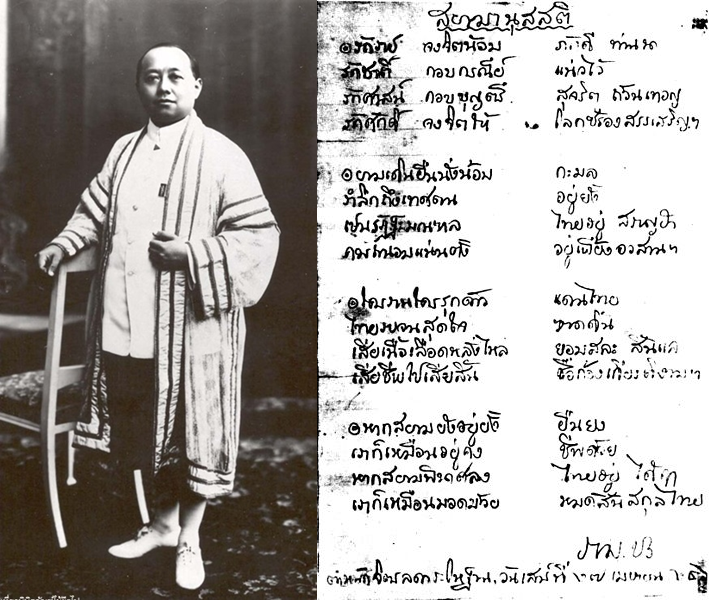
“Siammanussati” (สยามานุสสติ)
(Photo credit: โบราณนานมา)
- Chan (ฉันท์)
Chan features the rule of Kha-ru and La-hu. Thais modeled this form of poetry from 108 types of Pali and Sanskrit Chans in India, and adjusted the structure to fit the Thai language, assigning rhyming positions to make it sound more pleasing and flowing. Finally, Thais only adopted 25 types of Chan, but only six types are still popular today.
Chan must contain the exact number of syllables. Any word that is defined as Kha-ru or La-hu must follow the rule and appear at the specified position only. Any twists, even the slightest ones, are not acceptable in Chan as it will immediately ruin the poetic structure.
Notice the rhythm and the prominent short and long vowel sounds of this Intarawichian Chan (อินทรวิเชียรฉันท์) by Chit Burathat (ชิต บุรทัต) (1982-1947), describing flying snowflakes.
หยิมหยิมยะย้อยหยด หิมะสดสะอาดยล
พราวพราวสะพรั่งบน ติณะพฤกษะแพรวพรอย
หยาดหยาดยะเยือกเย็น ชละเป็นละอองฝอย
ลิ่วลิ่วละล่องลอย นภะแหล่งแสดงโดย
yim yim ya yoi yod hi ma sod sa at yon
prao prao sa prang bon ti na phruek sa praew proi
yaad yaad ya yueak yen cha la pen la ong foi
liu liu la long loi na pa laeng sa daeng doe-i
- Kap (กาพย์)
Kap is very similar to Chan except for the absence of Kha-ru and La-hu. It can be written together with Chan and is called Kap Ho Khlong (กาพย์ห่อโคลง), or Khlong wrapped in Kap.
วิชาเหมือนสินค้า อันมีค่าอยู่เมืองไกล
ต้องยากลำบากไป จึงจะได้สินค้ามา
จงตั้งเอากายเจ้า เป็นสำเภาอันโสภา
ความเพียรเป็นโยธา แขนซ้ายขวาเป็นเสาใบ
wicha muean sin khaa un mee khaa yoo daen klai
tong yak lam baak pai chueng cha dai sin khaa maa
chong tang ao kai chao pen samphao un sopha
khwam pian pen yo thaa khaen sai khwa pen sao bai
This Kap Yani 11 was part of the third Thai textbook of the series “Darun Suksa” (ดรุณศึกษา) written by Brother François Touvenet Hilaire (1881-1968), a French priest who was an important figure in Thai teaching.
- Rai (ร่าย)
For Rai, there is no specification on the number of lines or stanzas. It can be of any length, as long as there are rhyming words. If Rai is composed alternating with Khlong, we call such a structure “Lilit” (ลิลิต)
เกรงพระเกียรติระย่อ ฝ่อใจห้าวบมิหาญ ลาญใจแกล้วบมิกล้า
บค้าอาตม์ออกรงค์ บคงอาตม์ออกฤทธิ์ ท้าวทั่วทิศทั่วเทศ
ไท้ทุกเขตทุกด้าว น้าวมกุฎมานบ น้าวพิภพมานอบ
เถลิงพระเกียรติฟุ้งฟ้า ลือตรลบแหล่งหล้า โลกล้วนสดุดี
kreng phra kiat ra yo fo jai hao bo mi haan laan jai klaew bo mi kla
bo kha aat ork rong bo kong aat ork rit thao thua thit thua thet
thai thuk khet thuk dao nao mongkut maa nop nao phiphop maa norp
talerng phra kiat fungfaa lue tralop laeng laa lok luan sadudee
The above excerpt, in the form of Rai Suphap, was written as part of Lilit Taleng Phai (ลิลิตตะเลงพ่าย) by Prince Paramanuchitchinorot (1790-1853) who was appointed Supreme Patriarch of the Rattanakosin Kingdom (1782–1932). Lilit Taleng Phai recounted the victory of King Naresuan the Great (1555-1605) over the Uparaja of Mon.
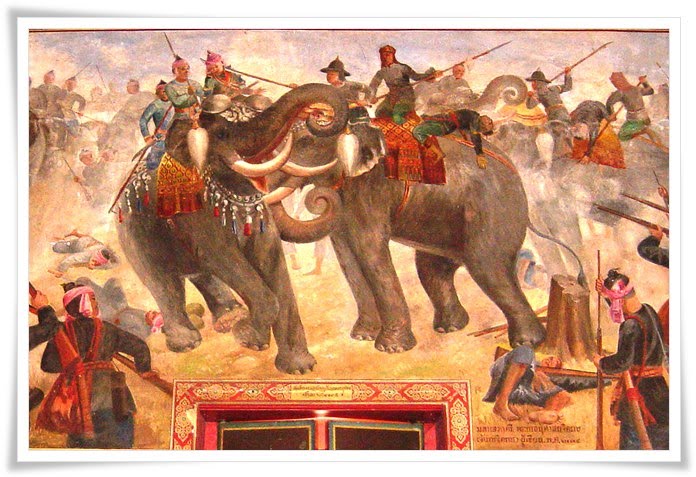
(Photo credit: วรรณกรรมพื้นบ้าน)
- Values
Thai poetry is not just a pattern of writing: it is an exquisite linguistic invention. Should we compare the Thai language to a fruit, then Thai poetry would be the meticulous process of carving the fruit worthy to be served to royals, rather than chomping it right away.
Poetry is a tool to highlight the beauty of the elements of the Thai language, such as the heavy/soft sounds, the living/dead words, groups of consonants and vowels, and the tones. Thai poetry is, therefore, inimitable and is best created and appreciated with an understanding of the language.
In terms of social reflection, poetry mirrors the artistry and refinement of Thai poets through the use of impeccable language, tactics to convey messages/stories, and emotional expression in every aspect and occasion of life. This is the rich culture of the Thai language, an inexhaustible part of the Thai heritage.
The story of “Thai Poetry” is a treasured aspect of classical Thai culture and heritage. The tradition of Thai poetic composition demonstrates the beauty and complexity of the Thai language, while the ability and inclination to employ poetry in various social settings demonstrates the artistic and creative nature of the Thai people. Furthermore, the vast trope of excellent poetic creations demonstrate that Thai writers possess refinement and skills, equal to figures from other great poetic traditions of the world. Join us in exploring more stories of Thailand and the Thai people, as we take you on a journey to discover Thainess.
Sources
- Kamchai Thonglor กำชัย ทองหล่อ. Lak pasa Thai หลักภาษาไทย [Thai Grammar]. Pra Nakorn: Ruam Sarn.
- http://www.phralan.in.th/coronation/index.php
- https://vajirayana.org/โคลงนิราศสุพรรณ-ของสุนทรภู่-ฉบับสมบูรณ์/โคลงนิราศสุพรรณ
- https://www.thailandfoundation.or.th/culture_heritage/women-in-thai-cuisine-part-1-the-classical-era/
- https://www.lib.ru.ac.th/journal/mar/mar_montrahtml
________________________________________________________________________________________________________________________________________
Author: Soonyata Mianlamai
Editor: Tayud Mongkolrat
23 January 2023


